Learners prefer having fun in class rather than feeling bored. That’s why instructors should create courses that could attract their attention and encourage them to engage in the coursework.
It becomes possible due to online course gamification, i.e. integration of various gaming elements into learning resources, from something minor like points and levels to something more advanced like virtual and augmented reality.
Gamification can improve eLearning experiences in many ways. It lets learners apply their knowledge and skills in practice, clearly seeing results of their choices. With leaderboards and success levels, they’ll get a better idea of their performance and areas to improve.
Levels also give learners an opportunity to track their learning progress and motivate them to take more action to achieve necessary goals. To reward them at the end of the day, instructors can use prizes and certificates. That way, everyone will look forward to more rewarding challenges waiting for them in the next lesson.
With the WordPress Quiz Plugin, you can easily implement these rewarding structures to keep users engaged and motivated, providing a fun, interactive learning experience that drives continued participation.
Gaming elements, incentives, and fun from online courses will speed up the entire process. Not only do learners stay engaged with course materials longer but also remain much more productive.
Wondering how to gamify online courses to get learners excited to proceed to every new module? Read on!
Give access to learning materials gradually

Traditionally, instructors share access to all the learning materials instantly. But such an approach deprives learners of the curiosity to go on with their coursework. These gamification strategies can significantly enhance engagement and completion rates for online courses, making learning more interactive and enjoyable for participants. Introduce a system that will let them unlock learning materials gradually, step by step.
Through gamification, you can divide your course into multiple modules based on the difficulty so that learners can proceed from one to another. By completing assignments, they will collect points and use them to access new modules. After trainees get done with simple stuff, they’ll be more confident to handle something challenging. It will create a sense of eagerness to go through the entire course.
Add progress bars to your courses
With progress bars, learners will see how far they’ve advanced and how much is still left to handle. Seeing how the progress changes on the bar, they will find enthusiasm to go on until course completion.
Whenever there’s some sort of stagnation, you can send them notifications to pick up where they left off. As a rule, learners usually feel motivated when instructors acknowledge their achievements. That’s why it makes sense to reward them with badges and grades when they show good progress.
To use badging and leaderboards in training, you can try SkillPath. The platform has an extensive, very tightly curated training library built by a professional in-house team of instructional designers. It covers a wide range of business topics from management and leadership to compliance, from technology to today’s most needed communication skills. The platform is quite intuitive and easy to use for learners of any skill level, allowing them to track their progress on a personalized dashboard, keep notes, and communicate with co-learners through discussion boards.
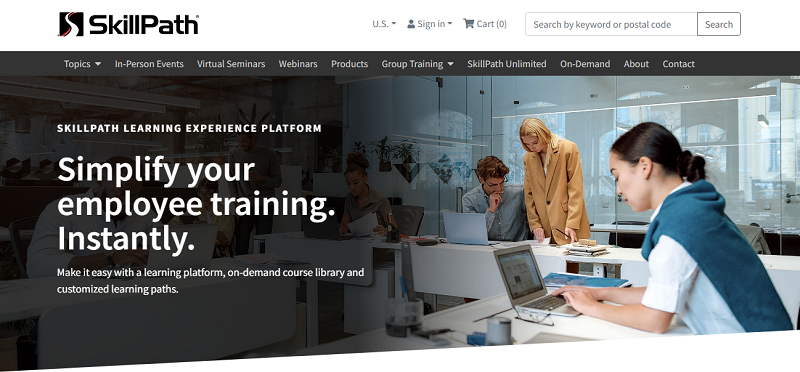
Introduce leaderboards to your course system
Leaderboards are gamification elements that let learners compete with others while exploring new stuff. As an instructor, you can introduce leaderboards to your LMS and share guidelines on how to achieve the highest level possible. It will encourage healthy competition among learners. Awarding points to them in the process, based on their performance in activities like quizzes or riddles, will develop habits of moving forward and never stopping at the achieved level.
Just make sure your leaderboards are always in view so that learners could keep in mind their need to climb up the ladder. You can locate them anywhere from the sign-in page to pop-ups that everyone will see before taking tests or quizzes.
Let learners retake tests
Learners should understand that it’s not over if they failed at the first try. Everyone has the right for a second or even a third chance, after all.
Giving them an opportunity to retake a test will increase their chances of better outcomes. They will be able to repeat the material learnt and approach a test from a different angle, which may turn out more successful for them.
Engage learners in the teamwork

To improve collaboration among learners, educators can create group tasks. Gamification systems make it possible to set up debates and provide online whiteboards where folks can share their opinions.
Competing with each other in teams, they will be more motivated to boast of their knowledge in front of their teammates and show themselves from their best side.
Give interactive quizzes
Interactive quizzes, e.g. gamified through video integration, can strengthen learners’ memorability, as they’ll have to recall the information they’ve learnt more often. For example, if you create a quiz at the beginning of a new course, it will activate knowledge obtained earlier. Doing the same somewhere in the middle will help trainees get ready for summative assessments.
What also matters in gamified quizzes is immediate feedback. It can be in the form of notes, comments, rewards, privileges, access to new modules, etc. Personalized feedback will help students change their learning techniques to achieve better academic goals.
Integrate a countdown timer into your learning system

A countdown timer is a great instrument to create a sense of urgency among students and help them cope with procrastination. They can earn points if they manage to complete assignments within the allocated time.
Instructors can also integrate countdown timers with automated alerts to remind learners of pending assignments and tests. That way, the problem of forgetfulness will get solved along with the development of time-valuing habits.
Set customizable avatars for learners
Another way to improve the interactivity of your courses is by using avatars. Instructors can enable learners to upgrade their avatars each time they complete an assignment or move to a new level.
Avatars also serve as effective tools to personalize the learning path. You can let students customize avatars in a way that would portray their individual qualities when they do the teamwork or, say, take part in debates.
Use eLearning platforms to speed things up
Gamifying eLearning experiences may seem complicated, but learning management systems can help you do the job quite easily. You’ve probably heard the big names like Moodle, Thinkific, and TalentLMS or even tried some of them. But the truth is the choice is much wider on the market.
There is also less known eLearning software that doesn’t yield to heavily promoted solutions. If you’re open to trying a platform with its own sophisticated features and flexible pricing plans, here are some of them to check out.
FLOWSPARKS
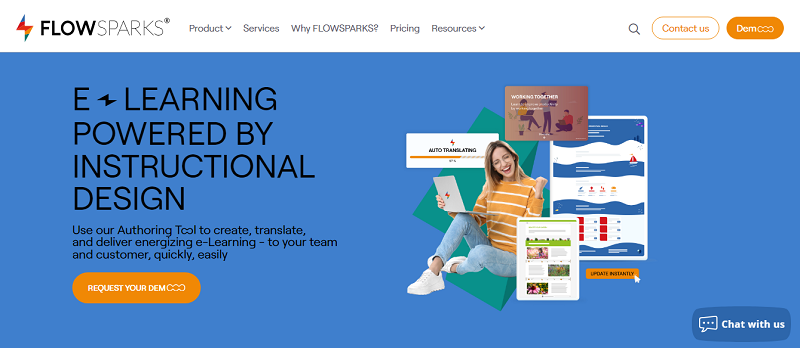
FLOWSPARKS offers a flexible and pragmatic built-in LMS system that can be enriched with gamified e-Learning training created with the Authoring tool. Unlike other LMS systems, FLOWSPARKS LMS can be used alongside existing LMS systems, to quickly and efficiently distribute digital training to a broader and more diverse audience.
In 2024, FLOWSPARKS launched an AI-powered Co-Author to speed up the e-Learning development process. The AI Co-Author uses generative AI and training source files to generate interactive e-Learning drafts with high-quality images in minutes.
accessplanit

Alternatively, if you run a training company and want to plan, manage and sell your training courses and resources all in one place, a training management system like accessplanit might be a better choice. Alongside eLearning hosting, accessplanit also provides course creation and scheduling, trainer and venue management, reporting and automation tools. Training management software (TMS) is a more well-rounded solution than an LMS, but it is typically more expensive. Read the Ultimate Guide to Training Management Software to find out more.
Classe365
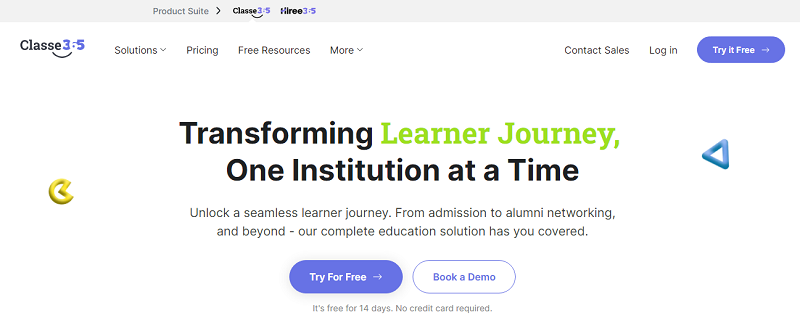
Classe365 is an end-to-end education management solution that automates administrative, teaching, and many manual, tedious tasks. While the student information system (SIS) eases out student data management and CRM supports enrollment and admissions, other modules help with attendance tracking, fee management, and more.
The learning management system (LMS) smoothens tracking and assessment, certification and compliance, analytics and reporting, and more. eLearning has become a breeze with Classe365’s comprehensive offerings. While the administrators save time by automating these tasks, they can focus on analyzing data to reach out to more authentic leads and successful conversions.
myQuest LMS

With myQuest LMS, you can easily create gamified training experiences structured around practical activities. Each activity is followed by personalized feedback from an expert, peers, or an AI assistant trained on your content. The system uses advanced technology to return to the skill-building basics, at scale.
myQuest also provides a bunch of habit-formation tools, allowing trainees to maintain a positive attitude towards the learning process. Thanks to powerful analytics, you can measure their performance and come up with the ways to help them achieve better results.
Academy of Mine
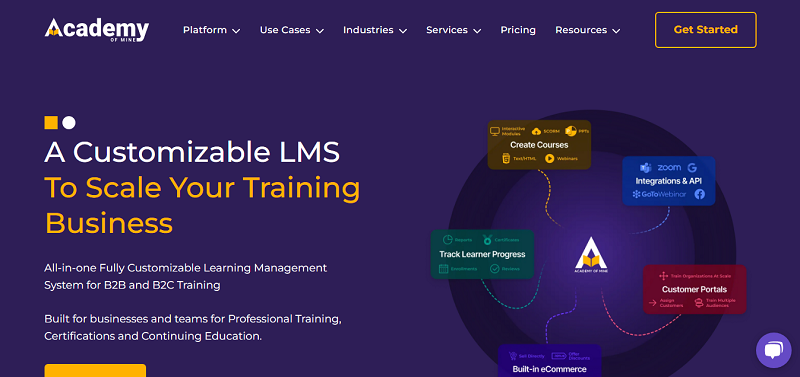
Academy of Mine is a flexible eLearning platform to create, sell, and manage online courses primarily in Professional Training industries (both B2B and B2C). It comes with a powerful reporting system, allowing you to track anything from trainees’ attendance rates and assignment scores to engagement levels and time spent on learning. Thanks to integration with Zoom and MS Teams, you can organize live classrooms that learners will be able to join without having to leave the LMS.
The platform is also perfect for monetization of your eLearning efforts – you can sell courses both from the storefront created with its help and your own existing online store such as Shopify or WooCommerce. White-label features allow you to brand your platform as if it is your own. You can even brand separately for each of your B2B Customers with the popular feature called Portals.
ELMO Software
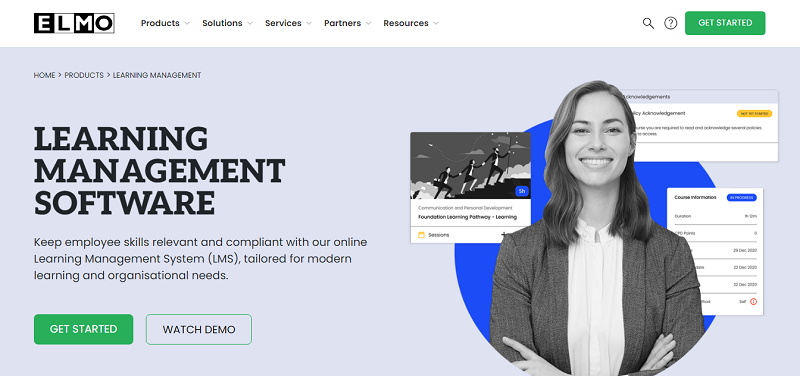
ELMO Software can help you build custom learning plans and facilitate skill and compliance training with its user-friendly LMS. Thanks to real-time reporting, you can analyze your team’s learning needs, track their course completion rates, and reward them with automated certificates. ELMO’s course builder makes it easy to create interactive online courses with images, videos, voiceovers, and quizzes, which will improve learners’ engagement levels.
There’s also a library containing over 400 SCORM-compliant courses, all customizable to your corporate needs. With built-in assessment tools, you can test trainees’ comprehension to make sure it meets your learning objectives.
Bottom line
As you can see, there are many ways to gamify online courses. Badges, avatars, quizzes, rewards, timers, and all the other gaming elements mentioned in this post will motivate learners to take more courses you provide.
Instructors use gamification to make eLearning more entertaining and less of a chore, thus motivating students to invest their time in it. Thanks to the exciting nature of gamified assignments, they’ll never get bored.
When learners complete easy tasks and proceed to more difficult stuff, it also gets them more focused on their goals. So, if you still doubt whether to gamify your learning process, the answer is definitely yes.